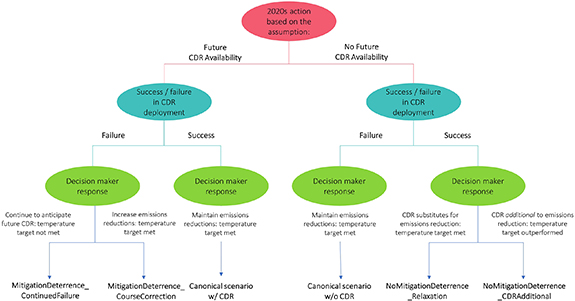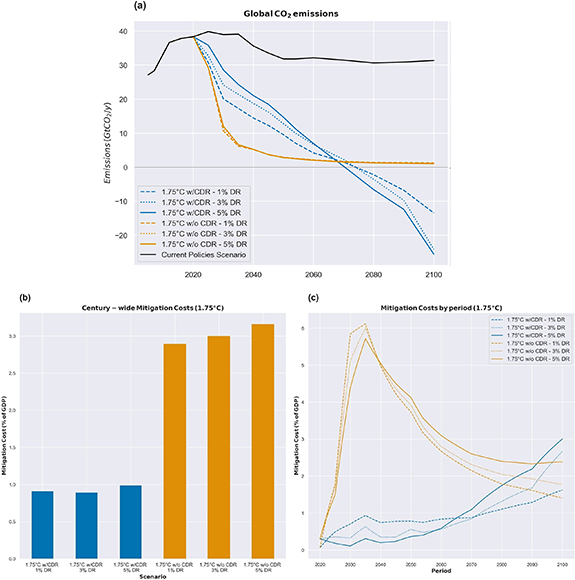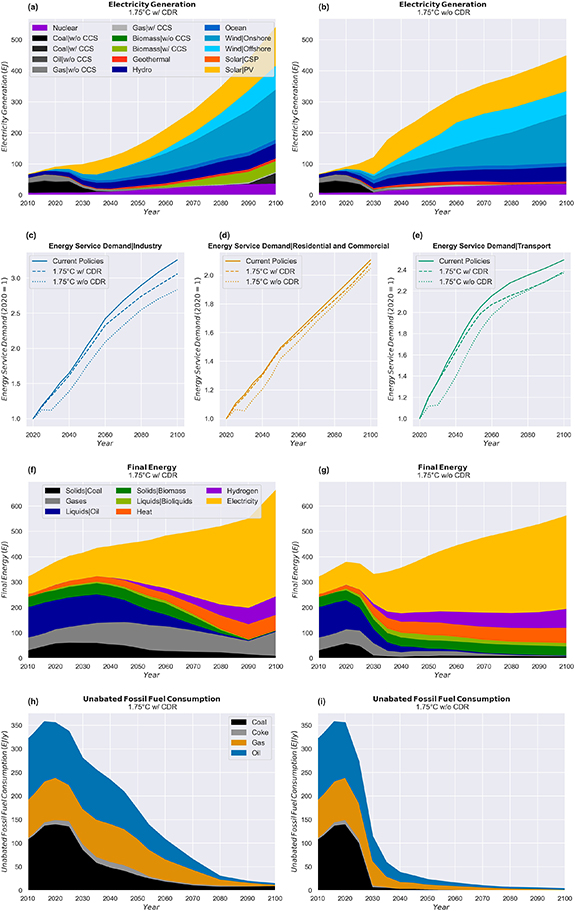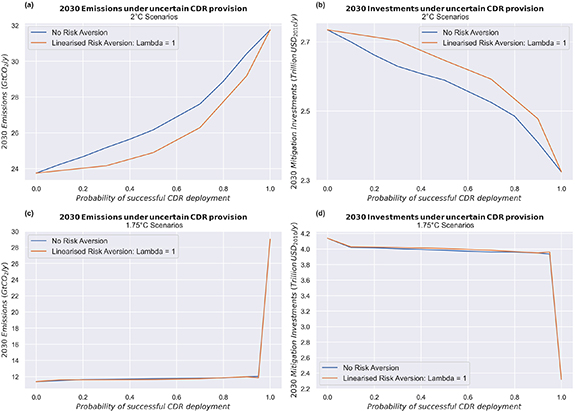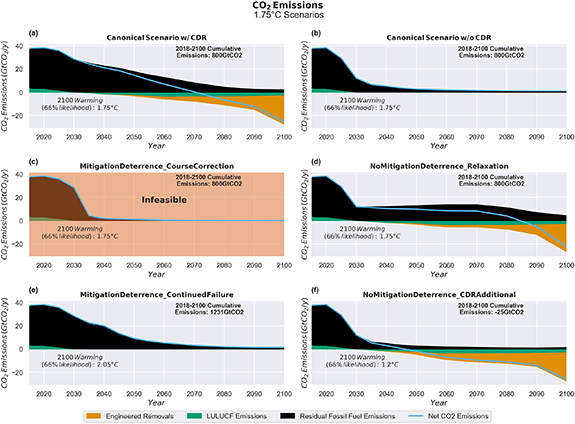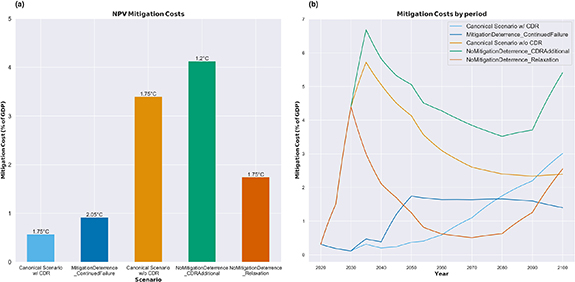Abstract
Carbon dioxide removal (CDR) features heavily in low-carbon scenarios, where it often substitutes for emission reductions in both the near-term and long-term, enabling temperature targets to be met at lower cost. There are major concerns around the scale of CDR deployment in many low-carbon scenarios, and the risk that anticipated future CDR could dilute incentives to reduce emissions now, a phenomenon known as mitigation deterrence. Here we conduct an in-depth analysis into the relationship between emissions reduction and emissions removal in a global integrated assessment model. We explore the impact of CDR on low-carbon scenarios, illustrating how the pathway for the 2020s is highly sensitive to assumptions around CDR availability. Using stochastic optimisation, we demonstrate that accounting for uncertainty in future CDR deployment provides a strong rationale to increase rates of mitigation in the 2020s. A 20% chance of CDR deployment failure requires additional emissions reduction in 2030 of 3–17 GtCO2. Finally, we introduce new scenarios which demonstrate the risks of mitigation deterrence and the benefits of formally separating CDR and emissions reduction as climate strategies. Continual mitigation deterrence across the time-horizon leads to the temperature goals being breached by 0.2–0.3 °C. If CDR is treated as additional to emissions reduction, up to an additional 700–800 GtCO2 can be removed from the atmosphere by 2100, reducing end-of-century warming by up to 0.5 °C. This could put sub-1.5 °C targets within reach but requires that CDR is additional to, rather than replaces, emission reductions.
Export citation and abstract BibTeX RIS

Original content from this work may be used under the terms of the Creative Commons Attribution 4.0 license. Any further distribution of this work must maintain attribution to the author(s) and the title of the work, journal citation and DOI.
1. Introduction
Carbon dioxide removal (CDR) refers to the direct removal of CO2 from the atmosphere, whether by enhancing natural carbon sinks or via engineered methods (Minx et al 2018). Some form of CDR will likely be essential if we are to meet the Paris Agreement goals (Rogelj et al 2018). Almost all scenarios that limit warming to 1.5 °C use CDR to some extent, either to offset residual emissions from sectors in which decarbonisation is deemed uneconomic or technically infeasible, and/or to compensate for overshooting the carbon budget. Some scenarios limit warming to 2 °C with no or limited reliance on CDR, but most see a large role for CDR in achieving this target as well (Hilaire et al 2019).
In many decarbonisation pathways, CDR has substantial value (Krey et al 2014, Riahi et al 2015, Strefler et al 2018) because it acts as a direct substitute for emissions reduction. This substitution happens in two ways. First, CDR can offset emission reductions in sectors that are deemed technically challenging and/or uneconomic to abate, such as aviation. This can enable a positive level of greenhouse gas emissions to continue in the long-term, while the economy as a whole remains at net-zero emissions (Geden et al 2019). Second, long-term CDR deployment can substitute for near-term emission reductions, enabling an overshoot in the carbon budget which is compensated for by future net-negative emissions (Johansson et al 2020). This allows the pace of near-term mitigation to be relaxed, facilitating continued short-term use of fossil fuel infrastructure and reduced asset stranding (Lemoine et al 2012, Realmonte et al 2019), but could breach the climate target, if there are restrictions on the level of overshoot permitted (Rogelj et al 2019).
While scenarios with limited carbon removal are emerging in the literature (Grubler et al 2018, Van Vuuren et al 2018, Rogelj et al 2019, Strefler et al 2021), many low-carbon scenarios still contain large-scale CDR which substitutes for emission reductions in both the near-term and long-term while achieving a pre-determined level of warming in a cost-optimal manner (Hilaire et al 2019). This is not the only possible role for CDR. Early conceptualisations of CDR deployment emphasised its role as a climate risk-management strategy (Obersteiner et al 2018). Nor is it necessarily the most useful to decisionmakers concerned with ambitious, robust and equitable climate action. Widespread concerns have been raised around CDR deployment in scenario analysis, including that betting on negative emissions could lead to mitigation deterrence (Markusson et al 2018, McLaren 2020), defined here as 'the prospect of reduced or delayed mitigation resulting from the introduction or consideration of another climate intervention' (Markusson et al 2018, p 1). Mitigation deterrence represents a risky (Fuss et al 2014) and unethical (Anderson and Peters 2016, Asayama and Hulme 2019) wager which runs at odds with central principles of environmental governance such as the precautionary principle (Rogelj et al 2019, Low and Honegger 2020).
We focus on the relationship between emissions reduction and emissions removal in a global integrated assessment model (IAM). The two forms of substitution between emissions reduction and CDR identified above correspond to two intertwined forms of mitigation deterrence, which we term:
- Intertemporal mitigation deterrence: mitigation in the present is reduced in anticipation of future CDR to compensate for excess emissions.
- Sectoral mitigation deterrence: mitigation in a certain sector is reduced, with residual emissions balanced by CDR at the same time to reduce net emissions.
We explore the following research questions:
- What is the impact of CDR availability on canonical low-carbon scenarios, where emissions reduction and emissions removal are treated as perfect substitutes?
- How does accounting for uncertainty in future CDR availability affect near-term emissions reductions and energy system transformations?
- What are the risks posed by mitigation deterrence in low-carbon scenarios and the benefits of avoiding mitigation deterrence?
We address these questions using three different scenario sets, exploring the relationship between CDR and emissions reduction in three distinct ways. These scenarios are discussed further in the methods section.
2. Methods
This analysis uses TIAM-Grantham (Loulou and Labriet 2008) to assess decarbonisation pathways. We explore the relationship between mitigation and CDR under two 2018–2100 carbon budgets of 800 GtCO2 and 1170 GtCO2, which lead to 2100 warming of approximately 1.75 °C and 2 °C respectively (66% likelihood) (Rogelj et al 2018). Temporary overshoot of the carbon budget is permitted in these scenarios. As our methodology involves producing scenarios without CDR, we do not incorporate 1.5 °C budgets, as it is very challenging to limit warming to 1.5 °C without at least limited reliance on CDR (Grubler et al 2018, Holz et al 2018, Van Vuuren et al 2018) 3 . Three different CDR options are represented in TIAM-Grantham; bioenergy with CCS (BECCS) (Azar et al 2013), direct air capture with CCS (DACCS) (Realmonte et al 2019) and afforestation/reafforestation (AR) (Humpenöder et al 2014). TIAM-Grantham reports CO2 emissions from fossil fuels and industry (FFI) and land-use, land-use change and forestry (LULUCF). The analysis infers non-CO2 emissions via post-processing of the results, using literature-derived relationships between CO2 and non-CO2 emissions (Lamboll et al 2020). Further work could fully endogenize all climate-relevant species. For more details, (see supplementary note 1 (available online at stacks.iop.org/ERL/16/064099/mmedia)).
2.1. Canonical decarbonisation pathways
The term 'canonical' here refers to scenarios in which emissions reduction and emissions removal are perfect substitutes, and future CDR availability is known with certainty. This is the case for most low-carbon scenarios in the literature and denotes the conventional representation of CDR which this research seeks to challenge.
Previous analysis has explored how CDR availability affects decarbonisation pathways (Giannousakis et al 2020), and how alternative strategies can reduce reliance on CDR (Grubler et al 2018, Van Vuuren et al 2018). However, it remains critically important for decision makers acting under uncertain CDR availability to understand its impact on key indicators such as sectoral emissions, fossil fuel consumption and low-carbon technology deployment. We elaborate on these metrics to an extent not yet done in the existing literature. We present results for 1.75 °C scenarios in the main text (see supplementary note 2 for 2 °C results). The choice of discount rate has also been shown to be a crucial parameter in exploring the role of CDR in decarbonisation pathways (Stern 2006, Nordhaus 2017, Emmerling et al 2019). We produce canonical scenarios using 1%, 3% and 5% discount rates.
2.2. Stochastic scenarios
The feasibility of large-scale CDR is highly uncertain (Smith et al 2016, Fuss et al 2018). Policymakers must therefore make decisions around the rate of emissions reduction today, with uncertainty around the future scale of feasible CDR deployment. The option to substitute mitigation today for future CDR, while understandable in cost-optimisation models using perfect foresight 4 , does not clearly map to the context of decision makers.
We use stochastic optimisation in which the future availability of CDR is uncertain. The availability of CDR post-2030 is modelled as a binary random variable, with probability of successful deployment p, and probability of deployment failure (1-p)

Uncertainty in CDR availability is resolved post-2030, at which point the model reverts to a standard deterministic scenario in which CDR and emissions reduction can substitute for one another and all variables are known with certainty. Stochastic runs better represent the near-term context of climate policy and provide a hedging strategy which minimises the expected policy cost across all possible outcomes.
We also introduce risk-averse stochastic optimisation. Decision makers might adopt a risk-averse strategy to decarbonisation which would prioritise avoiding high-cost outcomes (such as betting on CDR which fails to materialise). This could be due to the preferences of decision makers, or due to a concern for equitable mitigation (Ha-Duong and Treich 2004), in that the cost of a failed bet on CDR would fall on future generations, especially the poorest (Shue 2017). In risk-averse scenarios, the objective function to be minimised is not the expected cost, but also includes the variance of this cost weighted by a parameter λ, which we set as 1 in this analysis (supplementary note 1.4).
2.3. Myopic scenarios
Stochastic analysis provides an optimal near-term strategy under uncertain future CDR availability. However, if CDR becomes available, then emissions reduction and emissions removal are treated as substitutes. Stochastic optimisation does not therefore provide a full picture of the risks of mitigation deterrence (geophysical and economic), or the costs/benefits of avoiding mitigation deterrence across the entire time horizon of analysis.
We introduce a third scenario set, in which there is some degree of myopia in decision-making. Near-term action takes place based either on the anticipation of future CDR, or on the assumption that CDR will be unavailable. We then explore the implications of success/failure in large-scale CDR deployment. Where the assumption around future CDR availability proves correct (i.e. anticipated failure or success is realised), then decarbonisation continues as planned. However, if anticipated CDR fails to materialise, or if CDR becomes available when it had not been anticipated, further decisions must be made. While the theoretical possibilities are unbounded, we explore four central scenario archetypes. These are:
- MitigationDeterrence_ContinuedFailure. Emission reductions in the 2020s assume future CDR which then fails to be deployed. TIAM-Grantham is run myopically, with decisions in each decade made on the anticipation of CDR deployment in the next, which then fails to materialise. This represents a future in which large-scale CDR deployment always remains 10 years away, mirroring hype cycles observed in other technical promises (Reiner 2016).
- MitigationDeterrence_CourseCorrection. Emission reductions in the 2020s assume future CDR which then fails to be deployed. Mitigation then increases to compensate for CDR deployment failure, and the temperature target is met.
- NoMitigationDeterrence_Relaxation. Emission reductions in the 2020s proceed without betting on future CDR availability. Upon successful CDR deployment, decision makers relax the pace of mitigation, and CDR substitutes for emission reductions.
- NoMitigationDeterrence_CDRAdditional. Emission reductions in the 2020s proceed without betting on future CDR availability. Upon successful CDR deployment, decision makers treat CDR as entirely additional to emission reductions. The formal separation of mitigation and CDR leads to the temperature target being outperformed (McLaren et al 2019).
Figure 1 presents these scenario archetypes, with further detail given in supplementary note 1.5 and supplementary table 1.
Figure 1. Describes the narrative assumptions that underlie the myopic set of scenarios introduced in this analysis, which explore the risks of mitigation deterrence, as well as the costs and benefits of avoiding mitigation deterrence.
Download figure:
Standard image High-resolution imageGiven the prevalence of high discount rates in IAM analysis, we use 5% discount rates for the stochastic and myopic analyses. This aids comparability between presented analysis and the literature and enables us to isolate the impact of scenario design and uncertainty on mitigation deterrence, absent discount rate variations.
3. Results
3.1. The impact of CDR availability on canonical scenarios
Limiting warming to 1.75 °C without CDR requires very high rates of emission reductions in the next decade, with CO2 emissions falling more than two-thirds by 2030 to 11–12 GtCO2 y−1 (figure 2(a)). The total mitigation cost is correspondingly higher (figures 2(b) and (c)). Scenarios without CDR have century-wide mitigation costs of approximately 3% of GDP, rather than 1% when CDR is available. We use mitigation costs as a proxy for total decarbonisation effort (investment, operational costs and changes to demand structure), but do not equate this directly to a macroeconomic cost (Mercure et al 2019), as the wider macroeconomic impact of decarbonisation could well be positive (supplementary note 2.4). Mitigation costs as calculated by TIAM-Grantham are in general lower than those reported in SR1.5 (supplementary figure 9).
Figure 2. (a) CO2 emissions for 1.75 °C scenarios, with and without CDR, for 1%, 3% and 5% discount rates. A scenario that accounts for current climate and energy policy for the major economies is provided as a reference scenario in figure 2(a) (Grant et al 2020). (b) Average century-wide mitigation cost for each scenario, (c) distribution of mitigation costs across time. Costs here represent total energy system transition costs, including the impact of additional investment, fixed and variable operating costs, as well as welfare losses resulting from energy demand reduction via price elasticity. Figure 2(b) displays average costs, as the internal discount rate used in TIAM-Grantham varies across these scenarios, and as such cumulating costs is inappropriate (Emmerling et al 2019). For more detail on how these costs are calculated and presented, see supplementary note 2.4.
Download figure:
Standard image High-resolution imageThe distribution of effort (and hence mitigation cost) across time also varies strongly with CDR availability. In scenarios with CDR, mitigation costs grow across the time horizon, with the greatest burden allocated on generations in the latter-half of the century (Bednar et al 2019). Without CDR, costs peak in the mid-2030s at 5%–6% of GDP (as rapid near-term mitigation compensates for CDR's absence) and then fall as the extent of additional decarbonisation required in the latter half of the century is reduced. Much of this near-term decarbonisation effort arises from reduced energy service demands (figures 3(c)-(e) and supplementary figure 10). Scenarios without CDR have lower mitigation costs than those with CDR by the 2090s. Scenarios with lower discount rates display greater near-term costs but have lower long-term costs as expected.
Figure 3. Displays how the dynamics of the energy transition vary due to the availability of CDR, in 1.75 °C scenarios with a 5% global discount rate. Panels (a), (b) electricity generation ((c)–(e)) energy service demands ((f), (g)) final energy ((h), (i)) unabated fossil fuel consumption. For further discussion, see supplementary note 2.2.
Download figure:
Standard image High-resolution imageThe rapid emission reductions required to limit warming to 1.75 °C without CDR raise questions of transitional challenges and political feasibility (Strefler et al 2018, Jewell and Cherp 2019). The pace of energy transition and associated costs, especially prior to 2050, would have disruptive consequences for particular regions/sectors, and could have negative distributional impacts if these costs fall disproportionately on poorer households and regions. CDR's value partly arises from the ability to reduce these transitional challenges.
3.2. Energy system transformations in canonical scenarios
Meeting the Paris Agreement goals without large-scale CDR deployment necessitates faster electrification of the energy system (figures 3(a) and (b)). Electricity generation in 2050 is up by over 60% in scenarios without CDR compared to those with CDR, with growth largely driven by offshore wind and solar PV. Without the potential for overshoot, TIAM-Grantham front-loads renewable deployment in order to increase the pace of the energy transition. In the long-term there is reduced electricity demand due to the lack of DACCS, which requires substantial energy inputs (Realmonte et al 2019). As well as faster renewables deployment, scenarios without CDR display greater reductions in energy service demand growth compared to scenarios with CDR (figures 3(c)–(e)), particularly in the near-term. Demand reduction is greatest in industry and long-distance transport, where zero-carbon alternatives are less well-developed. However, demand still grows strongly across the time-horizon. Final energy falls across the 2020s, due to a combination of reduced demand growth and strong efficiency effects arising from fuel-switching from fossil energy to electricity and hydrogen (figures 3(f) and (g)). Increased use of renewable electricity and low-carbon fuels (biomass, renewable heat and hydrogen) coupled with demand reduction enables the rapid displacement of fossil fuels from the energy system (figure 3(i)). CDR enables a much slower reduction in the use of fossil fuels in the energy system (figure 3(h)). Supplementary note 2.2 provides further detail on the energy transition dynamics, including a sectorally resolved perspective.
The central question facing decision makers is how to act today, given the need for rapid decarbonisation and the pervasive uncertainties in the energy system. Table 1 presents some key decarbonisation indicators for the 2020s across 1.75 °C scenarios, showing how variations in CDR availability and the discount rate impacts on scenarios. The path for the 2020s in modelled scenarios is heavily contingent on the availability of CDR. Lower discount rates also increase the level of near-term action. The role of the discount rate is particularly important if CDR is available, as there is then flexibility in the shape of the emissions pathway. In the absence of CDR, the shape of the emissions pathway is constrained to be a rapidly declining curve towards zero, with cumulative emissions limited by the carbon budget. Discount rate variations therefore have more limited impact (supplementary note 2.3).
Table 1. The impact of CDR availability on the energy system transition in scenarios that limit warming to 1.75 °C with a 66% probability. Scenarios that limit warming to 1.75 °C in the absence of CDR have much greater action across the 2020s, which is demonstrated across a range of decarbonisation indicators.
| Decarbonisation Indicators for the 2020s: 1.75 °C scenarios with and without CDR availability | ||||||
|---|---|---|---|---|---|---|
| Scenario | Yearly emissions reduction rate | 2030 CO2 emissions (GtCO2 y−1) | Yearly mitigation investments (relative to 2020) | Yearly renewables deployment (GW y−1) | Demand reduction in 2030 relative to no-policy baseline (%) | Fossil share of final energy in 2030 (%) |
| CDR_DR-1 | 6.2% y−1 | 20.1 | +24% | 530 | 6% | 56% |
| CDR_DR-3 | 4.5% y−1 | 24.2 | +17% | 430 | 2.5% | 61% |
| CDR_DR-5 | 2.9% y−1 | 28.6 | +11% | 330 | 1.5% | 65% |
| NoCDR_DR-1 | 12% y−1 | 10.7 | +45% | 950 | 17% | 33% |
| NoCDR_DR-3 | 11.4% y−1 | 11.4 | +39% | 940 | 15% | 35% |
| NoCDR_DR-5 | 10.9% y−1 | 12.1 | +34% | 930 | 14% | 37% |
3.3. The impact of introducing uncertainty in future CDR availability on near-term emissions reduction
Emissions reduction in the 2020s occurs under deep uncertainty around the feasibility of CDR deployment. Figure 4 demonstrates the relationship between 2030 emissions (representing the level of action taken in the 2020s), and the probability of successful CDR deployment. It also presents mitigation investments in 2030 as a function of CDR probability. There is a convex relationship between 2030 emissions and the probability of CDR deployment. When uncertainty in future CDR is accounted for, TIAM-Grantham increases near-term action substantially, considering the potential for deployment failure more heavily than the potential for successful CDR deployment. This non-linear relationship is also seen in energy system investments, where the optimal extent of near-term investment increases concavely as the probability of CDR success declines.
Figure 4. Displays how 2030 emissions and energy system investments vary with the probability of successful CDR deployment when successful CDR deployment is an uncertain variable with probability p. Panels ((a), (b)) 2 °C scenarios, ((c), (d)) 1.75 °C scenarios.
Download figure:
Standard image High-resolution imageThe convex relationship between near-term action and CDR probability is amplified as the carbon budget shrinks, and with increasing risk aversion from decision makers. In 1.75 °C scenarios, a combination of mitigation deterrence in the 2020s and CDR failure leads to model infeasibilities. Therefore, a non-zero probability of CDR failure, even if small, requires substantial increases to near-term emissions reductions and energy investment requirements. In 1.75 °C scenarios, the impact of mitigation deterrence and subsequent failure is so great that this highly convex relationship is observed regardless of the level of risk aversion. In 2 °C scenarios, the larger carbon budget means that substitution and failure, while costly (supplementary note 3.1), does not put temperature goals entirely out of reach, and thus the sensitivity of near-term action to CDR probability is reduced. However, the relationship remains convex, and increasing levels of risk aversion further support the case for increased near-term action under uncertain future CDR availability.
Some of the near-term mitigation deterrence observed in IAMs is due to the fact that uncertainty in CDR availability is not represented. Many existing low-carbon scenarios may therefore underestimate the optimal extent of decarbonisation in the 2020s. For example, even if the probability of large-scale CDR deployment failure is only 20%, stochastic optimisation indicates that 2030 CO2 emissions should be ∼12 GtCO2 if warming is to be limited to 1.75 °C. This is an additional reduction of 2030 emissions by ∼17 GtCO2 compared to scenarios in which CDR is known with certainty—a substantial ambition increment which is neglected if CDR is treated deterministically.
Representing uncertainty in future CDR deployment heavily constrains the intertemporal substitution between near-term emissions reduction and long-term removals. This is because emission reductions that can be known with certainty are not equivalent to future removals which are uncertain. When uncertainty in future CDR is represented, TIAM-Grantham no longer treats emission reductions and CDR as fungible goods across the entire time-horizon, and the optimal level of near-term action increases accordingly. Even if decisionmakers want to 'make a bet' on CDR, they should be betting with the correct odds.
Uncertainty is not restricted to CDR deployment, but also exists around the feasibility of a range of mitigation options, including long-distance transport, energy-intensive industries and load-following electricity (Davis et al 2018). At the same time, there are many existing technologies with substantial mitigation potential that can be known with high certainty, including energy efficiency and renewable-driven electrification of buildings, surface transport and low-temperature heat (Lovins et al 2019). While this research focuses on uncertainty in CDR deployment, a broader consideration of uncertainty would further highlight the danger of forgoing near-term mitigation which can be achieved with (relative) certainty for future action which is inherently uncertain (whether CDR or mitigation in certain sectors). Uncertainty in the feasibility of future climate strategies provides a strong rationale to increase near-term decarbonisation, a rationale which strengthens with increasing climate ambition.
3.4. The risks of mitigation deterrence and the benefits of avoiding mitigation deterrence
Myopic scenarios extend the scope of analysis across the entire time-horizon, giving a more complete picture of mitigation deterrence in low-carbon scenarios.
Figure 5 presents emissions, cumulative carbon budgets and approximate end-of-century warming for the six scenario archetypes presented in figure 1. Anthropogenic CO2 emissions are disaggregated into residual energy sector CO2 emissions, LULUCF emissions and engineered removals via BECCS/DACCS. In the left-hand column, we see some of the risks of mitigation deterrence in low-carbon scenarios. If mitigation in the 2020s is based on anticipated CDR, emissions fall relatively slowly, down only 25% across the decade. If there is then deployment failure, the 1.75 °C goal falls out of reach (figure 5(c)). TIAM-Grantham is unable to solve for 1.75 °C while ensuring that supply meets demand across all sectors, and the solution is 'infeasible'. If there is a pattern of continued substitution and failure, with emission reductions continually delayed on the assumption of CDR deployment in a decade, then the carbon budget is exceeded by more than 400GtCO2, leading to the temperature threshold being breached by approximately 0.3 °C (figure 5(e)).
Figure 5. Displays the emissions pathways for six scenario archetypes which explore the implications of mitigation deterrence in low-carbon scenarios. Panels: (a) Canonical scenario with CDR, (b) Canonical scenario without CDR, (c) MitigationDeterrence_CourseCorrection, (d) NoMitigationDeterrence _Relaxation, (e) MitigationDeterrence _ContinuedFailure, (f) NoMitigationDeterrence _CDRAdditional.
Download figure:
Standard image High-resolution imageAvoiding near-term mitigation deterrence introduces substantial transitional challenges in the next decade. However, if CDR is then successfully deployed, a range of options present themselves. Two edge cases are considered. First, we could maintain the current temperature target but use CDR to relax the rate of emissions reduction (figure 5(d)/NoMitigationDeterrence_Relaxation). Here fossil fuel utilisation could plateau for 40 years before gently declining. NoMitigationDeterrence_Relaxation avoids intertemporal mitigation deterrence in the 2020s, but there is still intertemporal and sectoral mitigation deterrence in the long-term, as CDR substitutes for emissions reduction post-2030.
Alternatively, CDR could be incorporated into the decarbonisation strategy via a principle of additionality (figure 5(f)). Here emissions reduction continues at the rate required to limit warming to 1.75 °C without negative emissions, with CDR introduced as an additional climate strategy. In this scenario an additional 825GtCO2 is removed by CDR, and cumulative CO2 emissions across the century are negative, at −25 GtCO2. End-of-century warming is kept to approximately today's levels of ∼1.2 °C. Net-zero CO2 emissions are achieved in 2047, with cumulative emissions before net-zero of 480 GtCO2e, consistent with limiting peak warming to 1.5 °C with >50% likelihood. This represents a move towards a potential 'restoration' scenario (Hansen et al 2017), in which CO2 concentrations decline towards a desirable level, such as 350 ppm. Such a scenario is only possible if CDR complements, rather than substitutes for, emissions reduction. Energy system transformations vary substantially between these scenario archetypes (supplementary note 3.2).
Figure 6 displays the total mitigation cost for each of the scenarios presented above, given as net present value (NPV) and also plotted as a function of time. Avoiding mitigation deterrence in the 2020s requires substantially higher mitigation costs in the 2020s. If CDR is then successfully deployed and mitigation relaxed, costs fall dramatically from 2030 to 2070, before rising slightly in the long-term due to the economic burden of CDR deployment. The cost to populations in the latter half of the century is less than the cost of a canonical scenario which assumes CDR availability from the outset. Treating CDR as additional to mitigation and achieving sub-1.5 °C warming requires greater costs, but the additional cost compared to a canonical scenario without CDR is relatively minor, with NPV mitigation costs increasing only 20%. Crucially, the decision to deploy CDR post-2050 to achieve sub-1.5 °C warming would be kept open as an option for future generations, in the event that the additional costs were deemed acceptable.
Figure 6. Total resource costs for the scenario archetypes exploring the costs and risks of mitigation deterrence. Panels (a) NPV resource costs, (b) resource costs by period. Results are presented here for scenarios based on a 1.75 °C-consistent carbon budget with 5% discount rates. 2100 temperature outcomes associated with each scenario are also shown in panel a. For further results, see supplementary note 3. MitigationDeterrence_CourseCorrection is not shown here, as TIAM-Grantham fails to deliver a feasible solution in the context of 1.75 °C-consistent carbon budgets.
Download figure:
Standard image High-resolution image4. Discussion and conclusions
The modelling of low-carbon futures does not occur in a vacuum. There is a duality between the generation of knowledge and political regimes which act upon this knowledge (Beck and Mahony 2018, McLaren and Markusson 2020). The production of low-carbon scenarios is influenced by, and interacts with, political regimes, norms, and power relations. Avoiding mitigation deterrence requires more than simply informing decision makers of the risks and uncertainties relating to CDR. Wider cultural and political drivers of mitigation deterrence must be addressed (Markusson et al 2018). However, existing low-carbon scenarios generated by IAMs have significantly influenced the framing of climate strategy (Beck and Mahony 2018), and therefore exploring this issue further is essential.
This analysis provides multiple insights on the role of CDR in low-carbon scenarios. First, we have demonstrated the impact of CDR on canonical scenarios, including its role in facilitating greater fossil fuel consumption, reducing investment into renewables, and limiting the scale of demand pattern changes necessary in models. Second, using stochastic optimisation, we have shown that explicitly representing uncertainty in CDR availability significantly constrains the intertemporal substitution between CDR and near-term mitigation, providing an empirical justification for substantially increasing the ambition of near-term climate policy. Finally, we have presented scenarios which actively avoid or demonstrate the risks of mitigation deterrence. Continued mitigation deterrence could lead to temperature overshoot of up to 0.3 °C. The impacts of such a temperature rise would be catastrophic, particularly for vulnerable communities and ecosystems. Even if there is course correction in the 2030s, a decade of mitigation deterrence followed by CDR deployment failure would either put temper ature goals out of reach (1.75 °C) or substantially increase the cost of achieving them (2 °C). Avoiding mitigation deterrence in the next decade requires substantially greater near-term action, with corresponding costs and transitional challenges. It can however reduce the burden on future generations. Formally separating CDR and emissions reduction can ensure that climate strategies are robust to CDR failure and can enable deeper decarbonisation, consistent with a principle of ambition maximisation which acknowledges that dangerous climate change is here already and no future level of warming can truly be deemed 'safe'. This also allows us to provide new conceptions of the role and value of CDR, in geophysical terms (GtCO2 removed and temperature reduction), rather than economic terms (mitigation costs cut).
CDR could play multiple roles in low-carbon futures (figure 7). Three possibilities are highlighted—hedging against climate uncertainties, maximising ambition, and cost-optimising to smooth the transition to a low-carbon economy. Each of these functions could be of value to decision makers. For example, smoothing the transition away from fossil fuels could, in some sectors and regions, help facilitate a just transition and reduce near-term transitional challenges. However, given the alternative roles that CDR could play, the duality between imagined futures in IAM and the pathways suggested by policymakers (Beck and Mahony 2018) and the large vested interests in maximising fossil fuel extraction (Markusson et al 2018), it is inappropriate that in almost all modelled scenarios, the role of CDR is limited to facilitating greater fossil fuel consumption (figure 7(d)).
Figure 7. The appropriate role of CDR in low-carbon futures. The above panels demonstrate some stylised examples of the role that CDR could play in low-carbon futures. (a) Meeting temperature targets without CDR. (b) CDR used as a risk-management strategy to hedge against uncertainties in the climate system such as higher climate sensitivity (carbon budget is smaller for the same warming). (c) CDR used as an ambition-maximisation strategy to reduce temperature increase. (d) CDR used as a cost-optimising strategy to increase fossil fuel consumption while meeting the temperature target.
Download figure:
Standard image High-resolution imageAs the focus of global climate policy moves from agenda setting to implementation, it is essential that long-term targets are translated into substantial and rapid emissions reduction through ratcheting the ambition of Nationally Determined Contributions (NDCs). In this context, the relationship between anticipated future technologies and near-term action is critically important. This research demonstrates multiple reasons to increase the ambition contained in NDCs beyond that suggested by canonical scenarios, namely that considering uncertainty in future CDR deployment requires deeper emission cuts in the 2020s, that avoiding mitigation deterrence in the 2020s can actually reduce costs to future generations, and that avoiding mitigation deterrence can open up alternative uses for CDR upon the event of deployment success, such as ambition maximisation or hedging against climate uncertainties. While this research focuses on uncertainty in CDR deployment, the results could apply to other technological promises with an uncertain future potential. Near-term emission reductions should not be substituted for uncertain future contributions to decarbonisation. Low-carbon scenarios must not dilute the pressure for systemic change or lead decision makers to underestimate the potential for action now (Lovins et al 2019). As we move towards the first global stocktake, this research suggests that reappraising the appropriate role of CDR in tackling climate change is a matter of urgency.
Acknowledgments
We would like to thank Alexandre Köberle for valuable comments which helped advance this work. N.G. would like to thank the 'Science and Solutions for a Changing Planet Doctoral Training Programme' (SSCP DTP), the Natural Environment Research Council (NERC) (Grant No. NE/L002515/1), the Grantham Institute and the Department for Business, Energy and Industrial Strategy (BEIS) for supporting their PhD research. A.H., S.M. and A.G. acknowledge support from the H2020 European Commission Project PARIS REINFORCE (Grant No. 820846).
Data availability statement
The data that support the findings of this study are openly available at the following URL/DOI: https://zenodo.org/record/4740581#.YNBI4WhKg2w.
Footnotes
- 3
It is an underappreciated fact that even the low energy demand scenario (Grubler et al 2018) relies on AR to provide CO2 sequestration, although it does not rely on other CDR routes.
- 4
This dynamic is also observable in models that use recursive-dynamic methods in cost-effectiveness analysis. While decisions in any one period are made without knowledge of future time periods, the requirement to meet a pre-determined temperature target means that near-term action is still dependent on the long-term availability of decarbonisation options.


